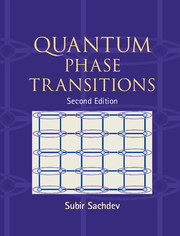From the Preface to the first edition
Published online by Cambridge University Press: 16 May 2011
Summary
The past decade has seen a substantial rejuvenation of interest in the study of quantum phase transitions, driven by experiments on cuprate superconductors, heavy fermion materials, organic conductors, and related compounds. Although quantum phase transitions in simple spin systems, like the Ising model in a transverse field, were studied in the early 1970s, much of the subsequent theoretical work examined a particular example: the metal–insulator transition. While this is a subject of considerable experimental importance, the greatest theoretical progress was made for the case of the Anderson transition of non-interacting electrons, which is driven by localization of the electronic states in the presence of a random potential. The critical properties of this transition of noninteracting electrons constituted the primary basis upon which most condensed matter physicists have formed their intuition on the behavior of the systems near a quantum phase transition. However, it is clear that strong electronic interactions play a crucial role in the systems of current interest noted earlier, and simple paradigms for the behavior of such systems near quantum critical points are not widely known.
It is the purpose of this book to move interactions to center stage by describing and classifying the physical properties of the simplest interacting systems undergoing a quantum phase transition. The effects of disorder will be neglected for the most part but will be considered in the concluding chapters. Our focus will be on the dynamical properties of such systems at nonzero temperature, and it will become apparent that these differ substantially from the noninteracting case.
- Type
- Chapter
- Information
- Quantum Phase Transitions , pp. xiii - xviPublisher: Cambridge University PressPrint publication year: 2011



